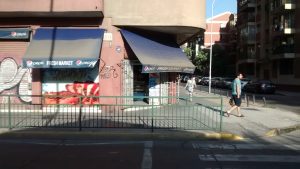One of the trends of a society commercialized, and now globalized, it is supposed, is the replacement of small shops by the big retail: stores give way to supermarkets. So, for example, Ruiz and Boccardo in The Chilean under Neoliberalism (2014) remind us:
‘abrupt decrease in the weight of the retailers within this category responds to its slow absolute growth, from which recovery is becoming harder, given the scarce interstices that for such forms of “entrepreneurship,” leave the important degree of concentration prevailing in these economic sectors’ (p 127)
In fact, however, does not diminish absolutely (which is what the quote). Difficult, and everything seems that it is possible to stay as a merchant retailer, although you can’t seem to expand as weight the niche still exists. There then, there is a question to ask: how is this possible?
My experience is that, at least in Santiago, there are differences very spacious-by-sector around the prevalence and pervivibilidad of these businesses. There are communes (the barrio alto in particular) where this type of trading is rare, but there are other sectors where they still have good health. In particular, I will talk below of the situation in the residential district of the Commune of Santiago (south of Alameda).
If I find myself in the corner where I live and road only one block for each of the four addresses I can find with 20 small businesses: 9 stores, 4 restaurants, 2 bakeries, 1 botillería, 1 grocery, 1 minisuper, 1 shop of medical products alternatives, 1 cyber-café (more a OK Market, being part of a chain, not a story). This in a neighborhood that, while it is filled with buildings (which may have 500 departments each one), at the same time is 3 blocks from the Mall and has 5 supermarkets on the outskirts. Then, why don’t all these people just buy in the supermarket? Why go to the stores and the like? (which are, in the end, more expensive).
Some possible dynamics:
- Due to the combination of levels of income, middle and low (C2 and C3 to use the nomenclature usual) with departments relatively small, it is not viable to purchase only weekly
- This is even higher for certain products: For example, it makes no sense to buy the bread for the week (and some of the products for the bread either, when you think about the so common avocado)
- For the daily shopping, and because of the location, the store may have advantages over the supermarket: it Is faster, in particular because several supermarkets nearby or do not have, or have parking lots small; and on more than one occasion the product is not at that supermarket (those in the center tend to be relatively small); or in fact, precisely for these perishables, the product of the supermarket is of poor quality.
- That given the size of households in several cases (many one-person households for example) those advantages can boost.
- Even if these advantages of a small business on a supermarket are only real for a small subgroup of those who live nearby, or even if they are only real for a small subset of the purchases of those who live there; the mere size of the population of the commuter permits (the population in addition will probably grow in the following years, as they are constructing a new building of similar dimensions to those mentioned above in a space that was previously occupied by houses of a floor and parking lots).
In any case, that for that way of life, buying in store can be something relatively stable, it is a conclusion that would seem to have reached even the architects of the area. There are several buildings that, in fact, have already included the space for business in your structure.
What does this lengthy description of what they are not even four entire blocks? A lesson that, in fact, is methodological: The initial appointment of Boccardo and Ruiz, who is a product of a macro-look, does not account for all the processes. To understand the livelihood of these businesses I have to see the concrete processes that enable them, and that, in turn, could be used to try to explain why there are areas full of these shops and others are not (i.and the barrio alto with structures completely different from income, of density, of order in the car etc). It is at this level that occur in the processes that end up producing the overall result.
And to show what business (and what diversity we are talking about) some pictures:





